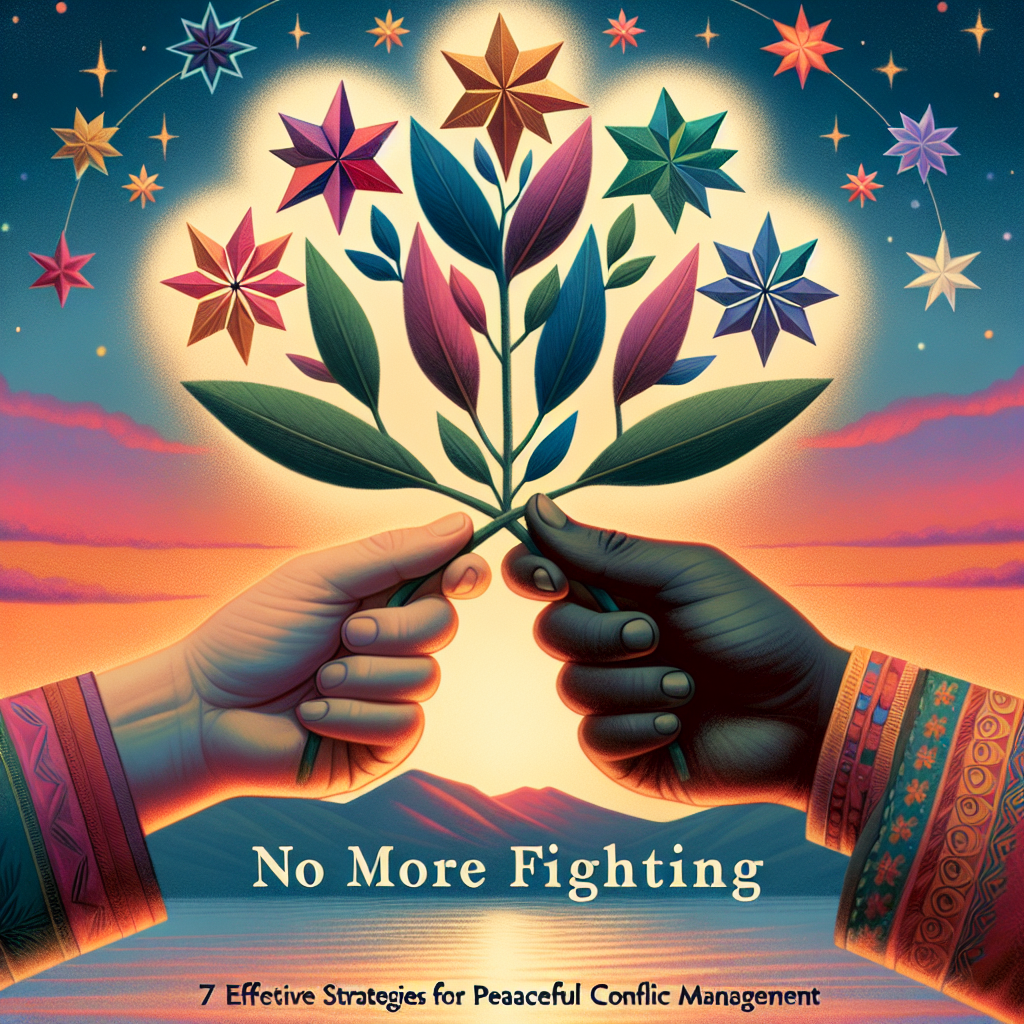
No More Fighting: 7 Proven Strategies for Peaceful Conflict Management
Introduction
In today’s fast-paced world, conflicts are an inevitable part of our personal and professional lives. Whether it’s a disagreement with a colleague, a misunderstanding with a friend, or a dispute within the family, unresolved conflicts can lead to significant emotional and psychological distress. This article, titled No More Fighting: 7 Effective Strategies for Peaceful Conflict Management, will provide you with essential techniques to transform confrontations into peaceful resolutions, allowing you to navigate life’s challenges with grace and confidence.
Conflicts often arise out of miscommunication, differing values, or unmet expectations. The stakes are especially high in settings where teamwork is crucial—like the workplace or among family members. Learning effective strategies to manage conflict not only fosters understanding but also strengthens relationships. Let’s dive into the practical steps you can take to transition from conflict to peace.
1. Foster Open Communication
The Power of Dialogue
Open communication is the bedrock of any healthy relationship. It allows individuals to express their feelings and concerns openly, reducing misunderstandings. When practicing the No More Fighting: 7 Effective Strategies for Peaceful Conflict Management, consider the following:
- Active Listening: Engage in conversations by truly listening. This means not only hearing words but understanding the underlying feelings.
- Nonverbal Signals: Be aware of body language. Nodding, maintaining eye contact, and an open posture can convey that you are engaged and interested.
Case Study: A Workplace Conflict
Consider a marketing agency where two team members had a disagreement over a project direction. Instead of confronting each other, they initially exchanged passive-aggressive emails that escalated tension. When they finally met face to face and utilized open communication, they discovered that both had similar goals but different ideas on execution. This conversation not only resolved their conflict but also led to a successful project collaboration.
Analysis: This case illustrates how valuable open communication can be in clarifying intentions and reinforcing common goals.
2. Identify Common Goals
Uniting for Resolution
In any conflict, identifying shared objectives can be a transformative approach. Ask yourself what both parties want and how you could work together to achieve those ends.
- Goal Orientation: Instead of focusing on the problem, redirect the conversation toward collaborative goals.
- Joint Problem-Solving: Use brainstorming sessions to identify solutions that cater to both parties’ needs.
Table: Shared Goals Matrix
| Party A Goals | Party B Goals | Shared Goals |
|---|---|---|
| Improve project quality | Speed up project completion | Deliver the project on time |
| Increase customer satisfaction | Reduce costs | Enhance overall client appeal |
Analysis: This matrix helps visualize goals, facilitating more integrated conversations that lead to peaceful resolutions.
3. Establish Ground Rules for Conflict Resolution
Boundaries for Respect
Setting ground rules can significantly enhance the effectiveness of your discussions. These rules create a framework that ensures both parties feel respected and valued during a disagreement.
- Time Limits: Ensure each party has an equal chance to speak without interruption.
- No Personal Attacks: Agreements to focus on issues rather than character will keep discussions productive.
Case Study: Family Disagreements
In a family setting, conflicts often escalate during holiday gatherings. One family implemented ground rules such as "no interrupting" and "focusing on the issue at hand." This resulted in calmer and more productive discussions about resource allocation for family trips that included everyone’s opinion.
Analysis: This family’s experience demonstrates that establishing boundaries can prevent emotional escalations and keep discussions grounded.
4. Utilize Mediation Techniques
The Neutral Third Party
When conflicts become more complex, a neutral mediator can provide an objective perspective. Mediation can dissolve tension and guide both parties to solutions that may not have been apparent.
- Professional Mediators: Consider hiring a mediator for workplace disputes.
- Peer Mediation: In schools or informal settings, enlist a mutual friend or colleague to assist in resolving disputes.
Chart: Mediation Process Steps
| Step | Description |
|---|---|
| Introduction | Explain the mediation process to all parties |
| Problem Identification | Clarify the issues and the feelings involved |
| Discussion | Allow each party to share their side unhindered |
| Development of Solutions | Brainstorm and agree on possible resolutions |
Analysis: A structured approach to mediation can demystify the process and ensure equitable participation.
5. Embrace Emotional Intelligence
Understanding Emotions
Emotional intelligence (EI) is crucial when navigating conflict. A high EI allows individuals to recognize their emotions and those of others, fostering empathy and effective communication.
- Self-Reflection: Take the time to assess your emotions and how they influence interactions.
- Empathy Building: Actively try to see the situation from the other person’s perspective.
Case Study: Emotional Intelligence in Leadership
In a tech startup, a manager noticed increased tensions among the development team due to tight deadlines. By employing emotional intelligence techniques—such as understanding stress levels in team members and providing emotional support—the manager cultivated a more collaborative environment. Instinctively addressing emotional undercurrents led to improved teamwork and reduced conflict.
Analysis: This case demonstrates that leaders who demonstrate emotional intelligence can significantly mitigate conflict by addressing underlying emotions.
6. Focus on Solutions, Not Blame
Solution-Oriented Mindset
Turning discussions from blame to solutions contributes to a more constructive atmosphere. Celebrating small achievements along the way can motivate parties to maintain focus on resolution.
- Avoid the Blame Game: Redirect conversations from guest-fall scenarios to collective problem-solving.
- Encourage Creativity: Invite brainstorming sessions to generate innovative approaches to conflict resolution.
Chart: Problem Solving vs. Blame-Focused Approaches
| Focus Area | Problem Solving | Blame-Focused |
|---|---|---|
| Mindset | Collaboration | Competition |
| Desired Outcome | Mutual agreement | Victory for one party |
| Emotional Environment | Supportive and positive | Hostile and negative |
Analysis: This chart illustrates how focusing on solutions invites collaboration and reduces tension, promoting a more successful conflict resolution.
7. Practice Forgiveness
Letting Go for Peace
Finally, the ability to forgive is paramount in conflict resolution. Holding onto grudges often prolongs disputes, hindering your ability to engage constructively in future interactions.
- Acknowledgment: Recognize the hurt caused, but also acknowledge the need to move forward.
- Rolling Forward: Channel any anger or resentment into positive action for your next encounter.
Case Study: Reconciliation in Teams
After a heated disagreement, two sales team members focused on forgiveness strategies. They initiated an open discussion acknowledging feelings and experiences. This transformational approach enabled them to rebuild trust, ultimately enhancing team dynamics and closing more deals collaboratively.
Analysis: This highlights that forgiveness can restore relationships, fostering collaboration even after tensions have flared.
Conclusion
Conflict is a natural part of human interaction, but it doesn’t have to end in strife. By implementing the strategies described in this article, which explores No More Fighting: 7 Effective Strategies for Peaceful Conflict Management, you can approach conflicts with a constructive mindset and transform adversarial interactions into opportunities for growth and understanding.
In summary:
- Foster open communication to bridge gaps.
- Identify common goals that unite rather than divide.
- Establish ground rules for respectful discussion.
- Utilize mediation techniques when conflicts intensify.
- Embrace emotional intelligence to understand yourself and others better.
- Focus on solutions rather than blame to promote a collaborative environment.
- Practice forgiveness to let go of resentment and build healthier relationships.
As you implement these strategies, remember: the ultimate goal is not just to end conflict but to create a culture of understanding and cooperation that will benefice all parties involved.
FAQs
1. What are the main causes of conflict?
Conflicts arise from various sources such as misunderstandings, differences in values or goals, competition for resources, power struggles, and poor communication.
2. How can I improve my listening skills?
Improving listening skills involves practicing active listening techniques, such as paraphrasing what the other person has said, maintaining eye contact, and being fully present in conversations.
3. What is the role of a mediator?
A mediator is a neutral third party who facilitates communication between parties in conflict to help them reach a mutually acceptable solution.
4. How can emotional intelligence help in conflict management?
Emotional intelligence helps individuals recognize and manage their emotions while understanding others’ feelings, leading to more empathetic communication and better conflict resolution.
5. Is it possible to resolve conflict without a formal process?
Yes, informal conflict resolution can occur if both parties are willing to engage in open dialogue and share their feelings constructively. Establishing a supportive environment can encourage this.
By following these effective strategies within No More Fighting: 7 Effective Strategies for Peaceful Conflict Management, you can create a foundation for lasting peace and healthier relationships.

















